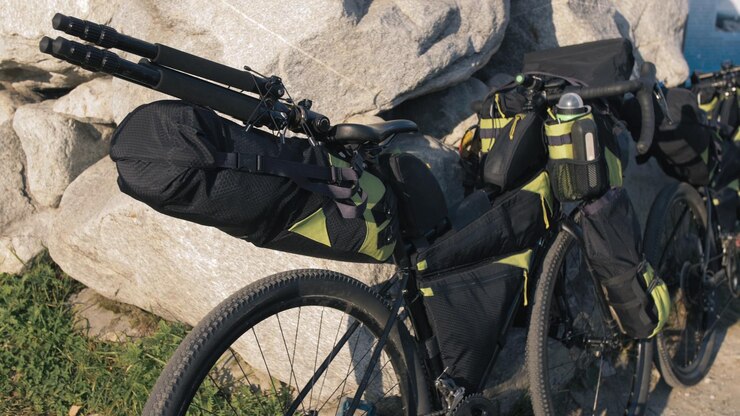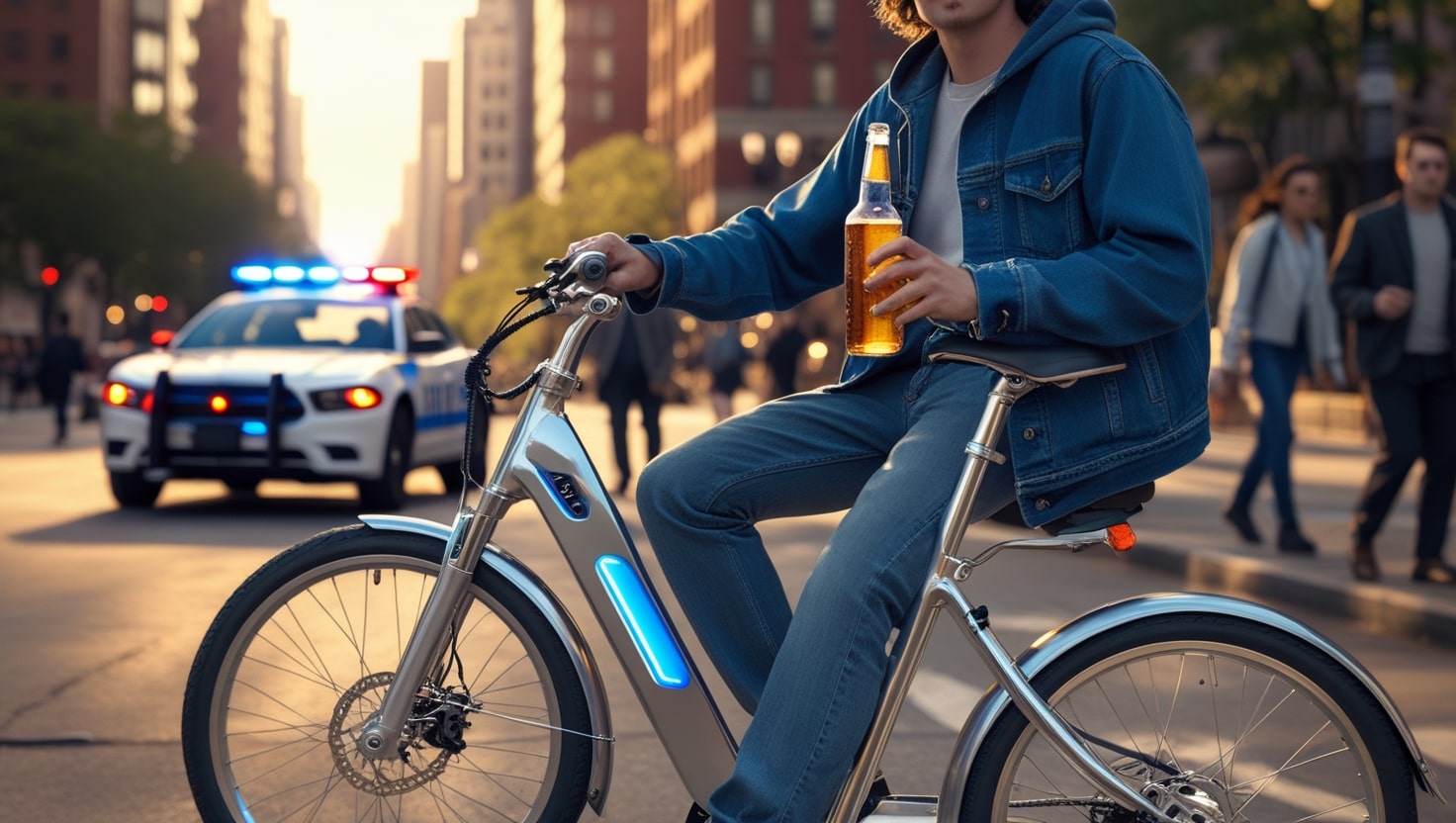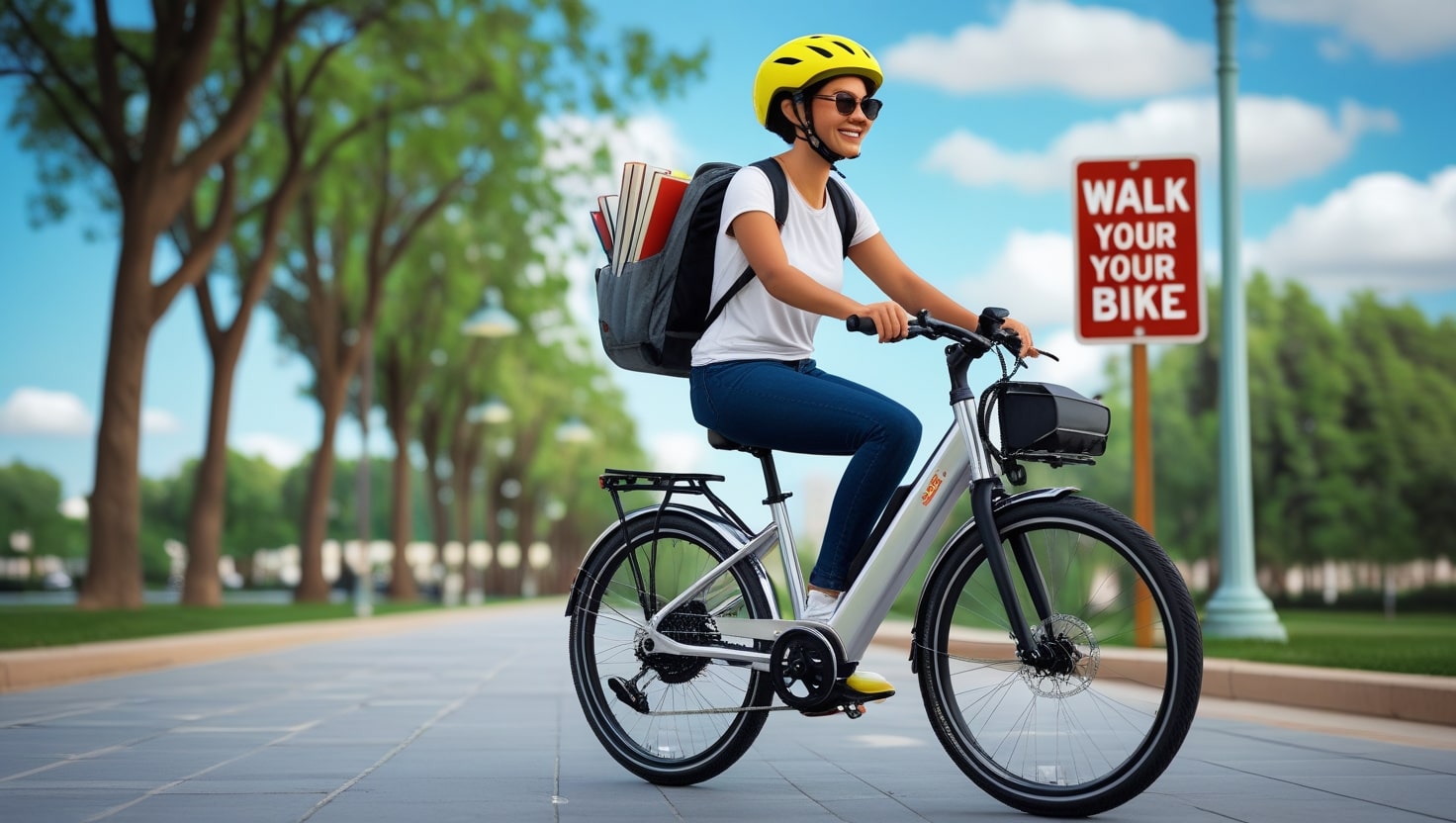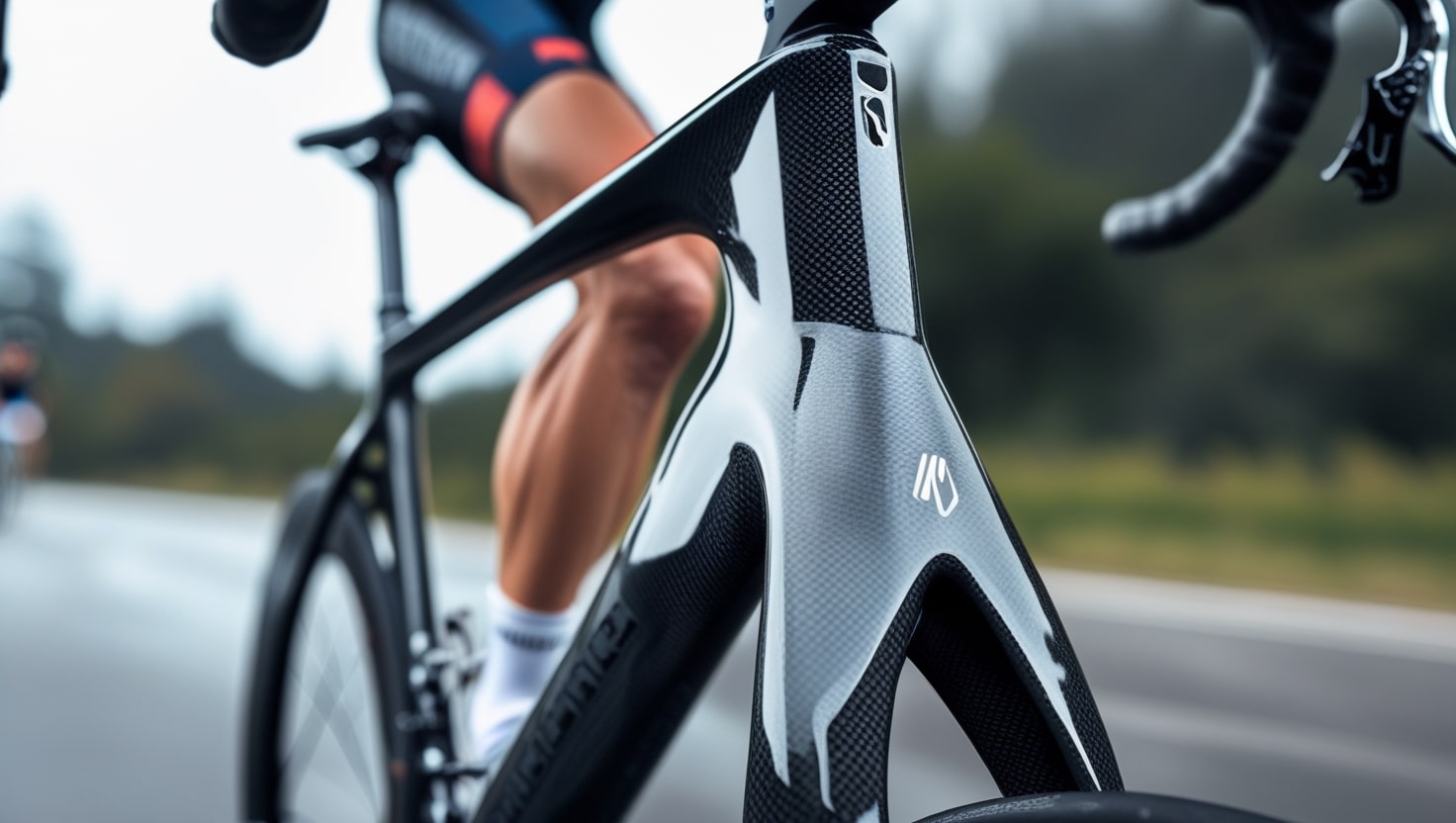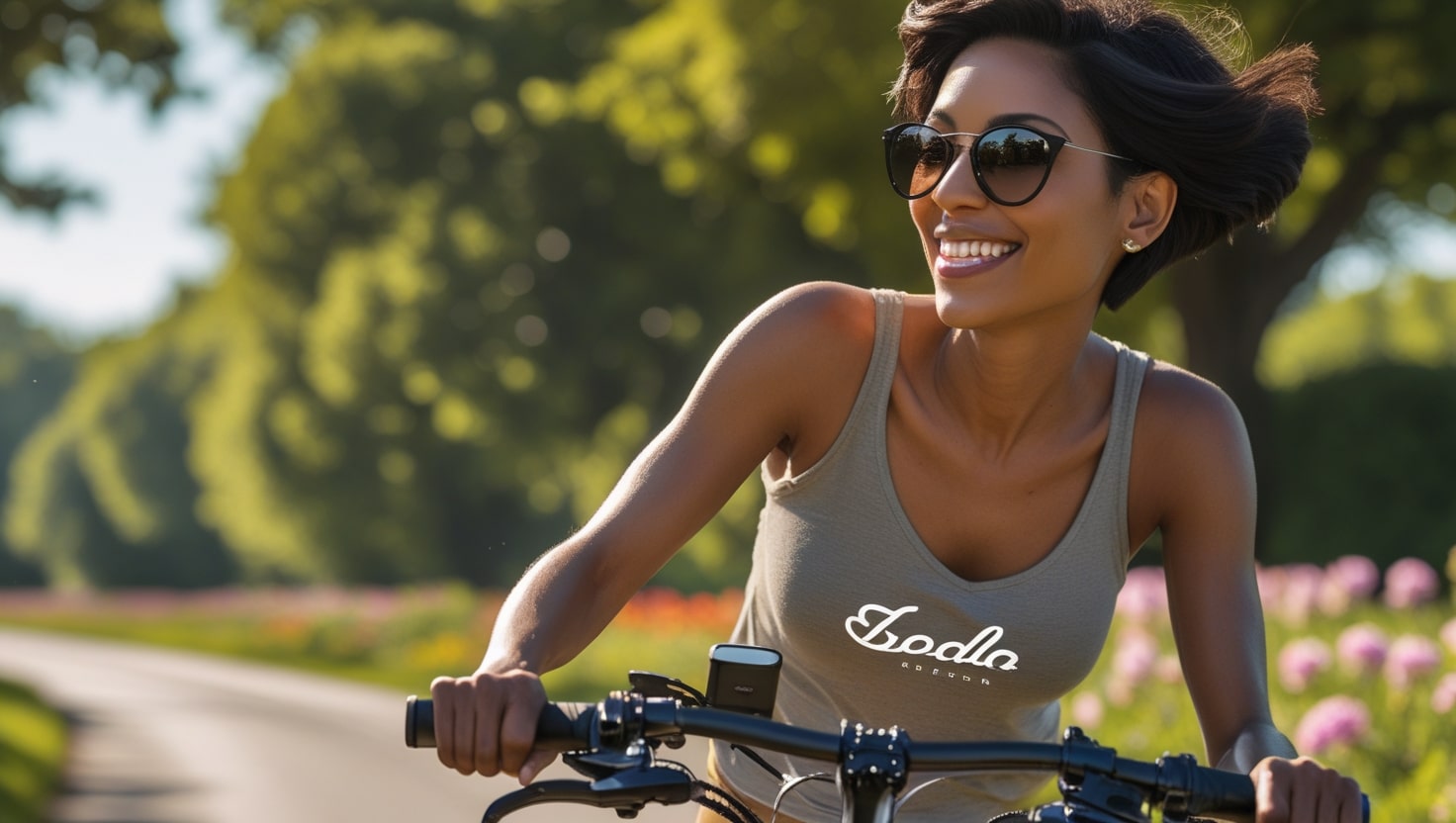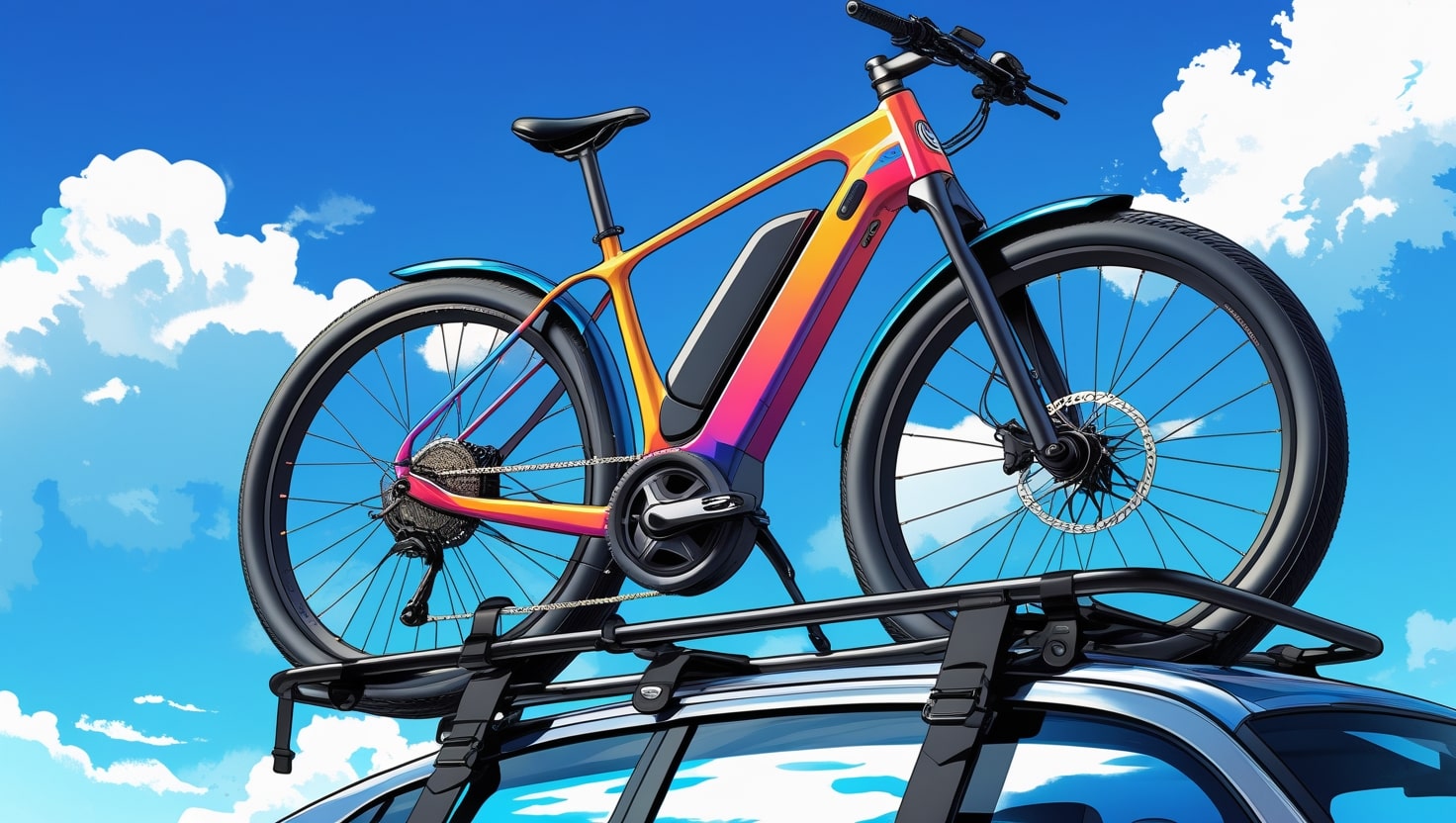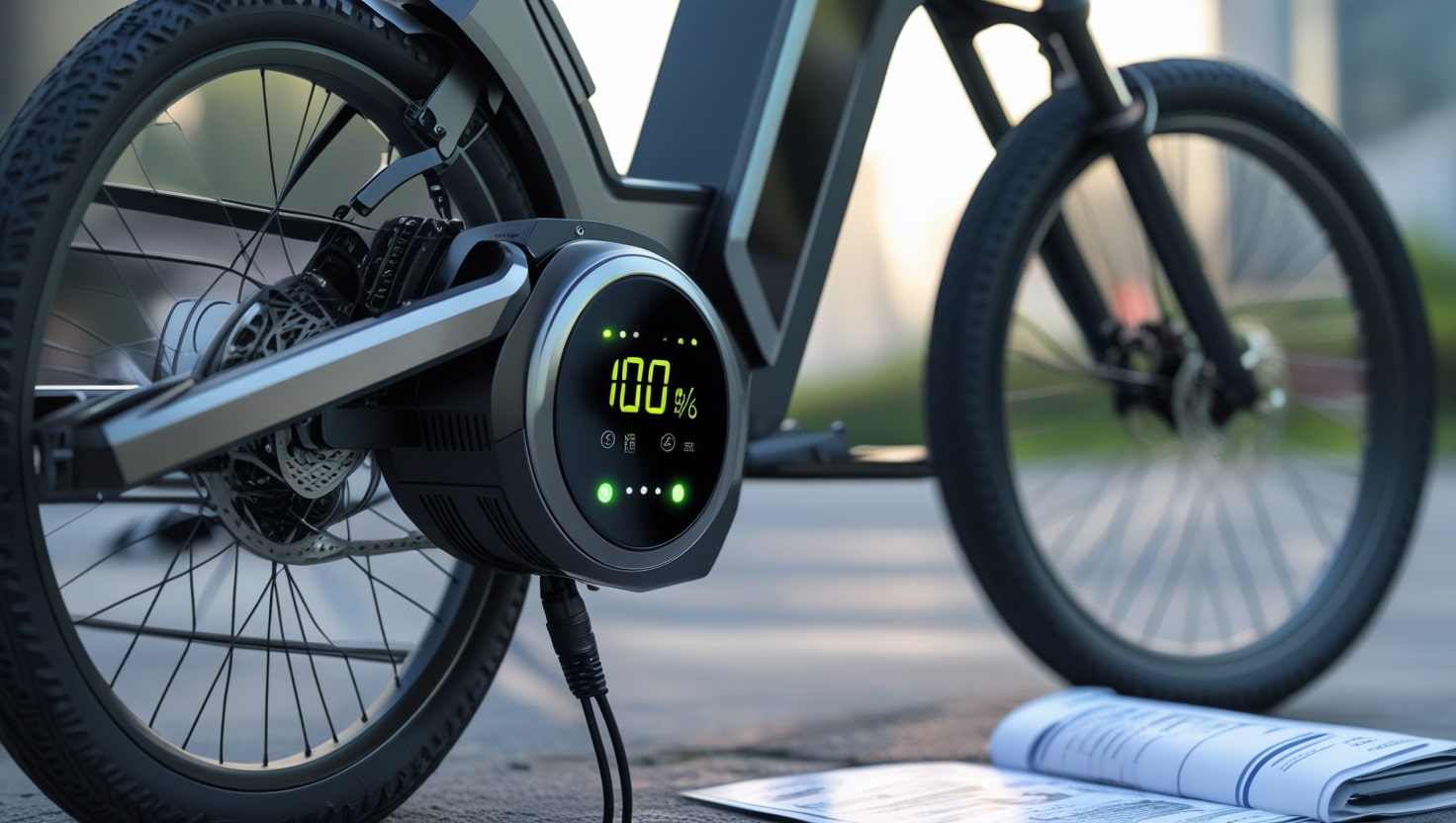When I first tried bikepacking, choosing the best saddle bag bikepacking was a game-changer. Whether you’re into recreational riding, daily commuting, or weekend racing, a reliable saddlebag makes a huge difference. I’ve personally tested various bags on rides through bustling downtown streets and rugged trails across Colorado’s scenic Front Range. A good bag offers versatility, comfortably carrying your essentials, from repair tools to overnight camping gear, without compromising your ride.
Choosing between a small seat bag and a full-sized option depends heavily on your journey. A compact, seat-mounted pack is ideal for shorter rides in the city or quick gravel jaunts, giving you just enough room to carry the basics for a roadside fix. On longer adventures, such as multi-day trips exploring trails in Utah or rides connecting Denver to nearby mountains, you’ll appreciate the increased capacity of larger seat packs designed specifically for extensive mountain bike or gravel bike trips.
Through my experience, I’ve found the easiest way to get started is by choosing a versatile saddlebag suited to your typical riding style. The best bags adapt seamlessly, whether you’re hitting trails on mountain bikes, exploring backroads with road bikes, or going deep into wilderness on your first overnight trip.
overall best saddle bag bikepacking: Restrap Saddle Bag
Material: Built with military-grade 1000D Cordura and rugged VX21 fabrics, this bag ensures durability even on the roughest trails.
Weight: Options are lightweight and manageable at 15 oz for the smaller version and 18.9 oz for the larger one, ideal for longer rides.
Capacity: Versatile choices of 4.5 liters, 8 liters, and up to 14 liters, accommodating everything from quick rides to extended bikepacking journeys.
Waterproof: Completely reliable in wet conditions thanks to waterproof materials, making sure your gear stays dry.
Attachment system: A highly effective and adjustable strap ensures secure mounting, allowing quick adjustments on the trail.
What we liked: I particularly appreciated its simple design, which makes it incredibly easy to load and unload, with minimal sway even during aggressive riding.
What we didn’t like: Occasionally, the harness lacing can slightly hit the rear tire when the bag is heavily packed or improperly adjusted.
After multiple trips and having personally tested many saddlebags, the Restrap Saddle Bag stands out as the best overall option I’ve used. Installing this best-designed seat bag on practically any bike is a breeze, and it gets even easier when you need to quickly and easily reach your gear while riding. I opted for the larger 14L version, especially useful when tackling challenging rides along rough trails on the Colorado Front Range, and was genuinely shocked by how little the higher-volume saddle bag swayed, even while pedaling hard and standing up on steep climbs.
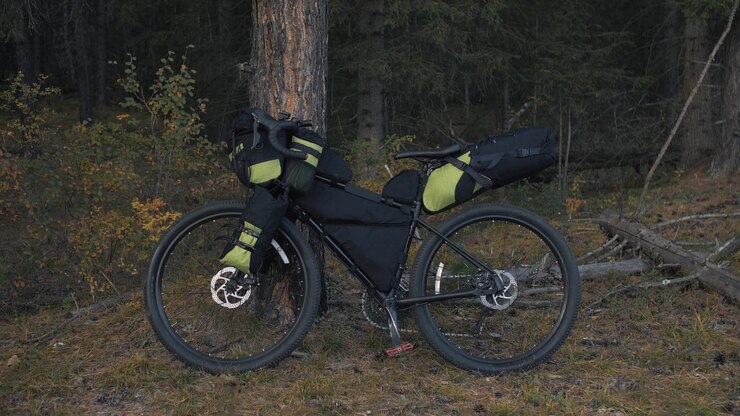
Harness and dry bag
The Restrap Saddle bag’s ingenious two-part design, which combines a robust harness and an independent dry bag, is one feature I like the most. The outer harness uses rigid plastic sheets sandwiched between layers of durable Cordura, securely laced together with strong paracord, allowing you to easily customize the fit. Inside, the dry bag stuff sack features a reliable roll-top closure and fully taped seams, making it completely waterproof—even in a heavy downpour, your gear will stay dry. This inner bag is smartly shaped to perfectly fit inside the outer harness bag, ensuring stability and ease of packing during all your rides.
Attachment system
One feature that truly impressed me about the Restrap Saddle Bag is its excellent attachment mechanism, which makes it quick and easy to attach to almost any bike. The exterior harness bag uses two straps—one connects securely around your seat post, while the other wraps around your saddle rails. Unlike many typical bags, Restrap uses rigid velcro straps, uniquely layered with a rubberized double strap design, making sure the bag stays securely in place. In order to prevent rubbing between the bag and seat post, an inside strap is also included with a ⅜” foam spacer.
The all-important straps connecting the bag to your saddle rails use simple webbing buckles paired cleverly with a separate ladder-locking buckle, letting you easily tighten the straps and secure them exceptionally tight. From personal experience, the tighter you can get these straps to wrap around your saddle rails, the less your seat bag will sway, even on the roughest trails.
Loading and unloading
One thing I’ve noticed can be quite challenging on any bikepacking trip is packing your gear each morning before leaving camp, especially reattaching bags to the bike. This procedure is greatly shortened by the Restrap’s ingenious design. Because its sturdy harness stays attached, you simply remove the separate dry bag using its slick magnetic buckle and effortlessly pull out your essentials. This setup makes it incredibly easy to quickly unload at the end of a long day, simplifying both evening setup and early starts.
Lacing system
Although the Restrap saddlebag is excellent overall, one minor flaw is in the lacing system used to attach the two harness pieces together. It tightens using a simple toggle, which unfortunately won’t hold the laces tight enough when you try to reduce the bag’s size. Another small annoyance is the extra length of the lace, which might rub against your rear tire if left hanging loose. Thankfully, these issues are quite minor and can easily be fixed by tying a knot in the lace and cutting off any excess cord.
Best Saddle Bag For Commuters: Deuter Cabezon SB 16
Material: Made from tough PFAs-free 600D polyester TPU, durable for everyday commuting.
Weight: Reasonably lightweight at 1 lb 4.5 oz, suitable for daily rides.
Capacity: Ample storage of 16 liters, perfect for carrying daily essentials comfortably.
Waterproof: Features IPX4 waterproof protection, ideal for unexpected city showers.
Attachment system: Uses convenient hook and loop fasteners allowing quick adjustments when in a rush.
What we liked: Loved the separate harness and practical inner stuff sack; the bag has a genuinely secure mounting system that doesn’t sway, even on uneven roads.
What we didn’t like: We found the buckles on the harness a bit difficult to figure out initially, though this improves with practice.
For daily commuting, my top choice is the Deuter Cabezon SB 16. This bike saddle bag combines a versatile bag harness with an inner dry bag, creating an excellent dry bag combo that’s incredibly convenient. What makes this bag perfect for commuters is its thoughtful design, especially the separate harness that stays attached to your bike. This allows you to quickly remove just the inner dry bag, which is very easy to carry, making your daily routine much smoother.
Like the Restrap Saddle Bag, the Deuter’s system simplifies the often tedious work of repeatedly attaching a large bikepacking seat bag every time you ride. With its practical stuff sack and overall ease of packing, it’s truly a great, all-around seat bag designed specifically with busy commuters in mind.
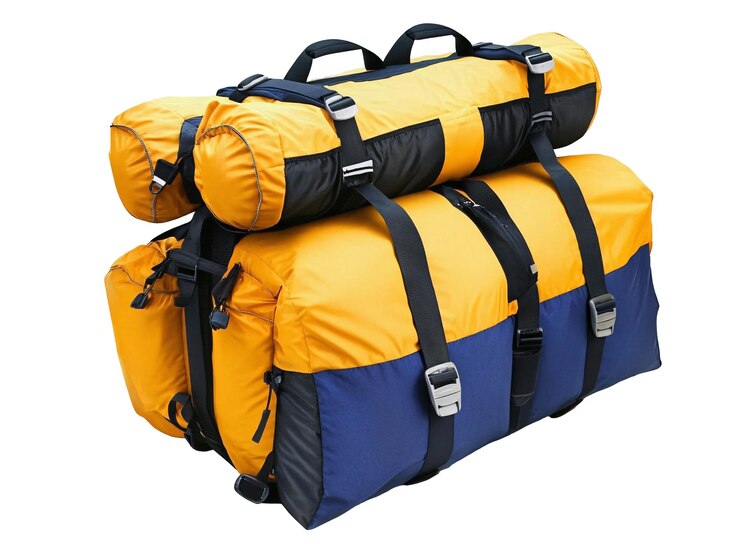
How we tested
To fully understand how these bags perform, we took the Deuter Cabezon on various adventures during an entire summer of cycling around Colorado. We tested it thoroughly on everything from overnight trips and long days of bikepacking to regular daily commutes and quick day trips. It truly shines when biking to trailheads, easily holding our trail running gear, carrying groceries back home, and helping us comfortably carry stuff during extended long rides, especially when we didn’t want the weight of a backpack on our bike.
Ease of use
The stuff sack design of this bag makes packing your gear a total breeze—something I personally value after long days on the trail. The clever harness securely holds the inner bag steady, and there’s just enough space on the sides to easily shove in extra items you might need handy, like snacks or a lightweight jacket.
Attachment system
One of my favorite features of this bag is its reliable harness system that easily mounts onto the bike using sturdy buckles that loop over the saddle rails. Additionally, two large Velcro straps securely wrap around the seatpost, providing extra stability. The inner dry bag is a cleverly designed stuff sack that smoothly slides into the harness and firmly clips into place with straps attached to either side. A further advantage is the additional strap that wraps over the top, neatly compresses the inner stuff sack, ensuring nothing moves or rattles, even on rough terrain.
Materials
One thing I always look for in the best bikepacking gear is build quality, and this bag’s harness delivers with heavy-duty, PFAs-free 600D polyester TPU that’s tough and long-lasting. The inside stuff sack is surprisingly easy to load and unload thanks to the stiffening material sewed into the cloth at the bottom. On top, a zig-zag shock cord adds a clever touch, letting you secure a jacket or other small items on the outside when you’re short on space.
The inner stuff sack itself holds a solid 16-liter volume and is made from a thinner 220D polyester TPU—still rugged, but a bit lighter for everyday use. It’s rated IPX4 waterproof, which means your gear will stay dry through heavy rain, though it’s not designed for being fully submerged. I also appreciate the practical roll-top closure and air-release valve, both of which help you pack the bag tighter while keeping moisture out.
Compression
The ability to load and unload more easily is one of the main benefits of a seat-mounted harness system, particularly when an inner bag is involved. This setup gives you the flexibility to pack a wider range of items, like a running vest or running shoes, that don’t usually fit well in traditional bags. The harness helps compress those odd-shaped items and transforms what would’ve been a lumpy stuff sack that might swing wildly into something that holds much more securely in place than a seat bag that attaches straight to the bicycle.
The bottom line
When it comes to finding your top choice for a saddle bag with larger capacity, both the Restrap Seat Bag and the Cabezon stand out as solid contenders. The Restrap is our top pick overall—especially if you prefer a traditional bike bag style made with tough Cordura materials. But if you’re drawn to a more modern look with outdoorsy, shiny materials, then the Cabezon might suit you better. Either way, whichever one you choose, you won’t be disappointed.
Related: What is Crankset?
best saddle bag bikepacking: Ortlieb Seat Pack QR
Material: Built with PU-coated, IP64 rated dustproof and splashproof nylon fabric for tough weather protection.
Weight: Weighs 22 oz, making it a solid yet manageable option for longer rides.
Capacity: Offers a generous 13 L of storage—great for carrying bulky gear without overloading.
Waterproof: Fully waterproof, keeping your essentials safe and dry on wet trails.
Attachment system: Uses a hook-and-loop fastener combined with a quick-release attachment system for easy, secure mounting and removal.
What we liked: The quick-release attachment system is smooth to operate, and the plastic bottom plate adds structure and protects the bag while riding. It also showed minimal sway when fully loaded.
What we didn’t like: The quick-release feature doesn’t work well with some saddles, which could limit compatibility depending on your setup.
The Ortlieb Seat Pack QR stood out in every way during our field tests—it had the least side-to-side sway of any bikepacking-sized saddle bag we tested, making it the clear winner for the best saddle bag for bikepacking. While it narrowly missed our pick for the best bike saddle bag overall due to compatibility issues with certain leather Brooks saddles—especially the Brook B67 and B17 models clamped far back on their saddle rails—this saddle compatibility issue is really the only flaw we could find. For most riders who aren’t using these popular bicycle touring setups, this saddlebag performs exceptionally well across all kinds of bikepacking adventures.
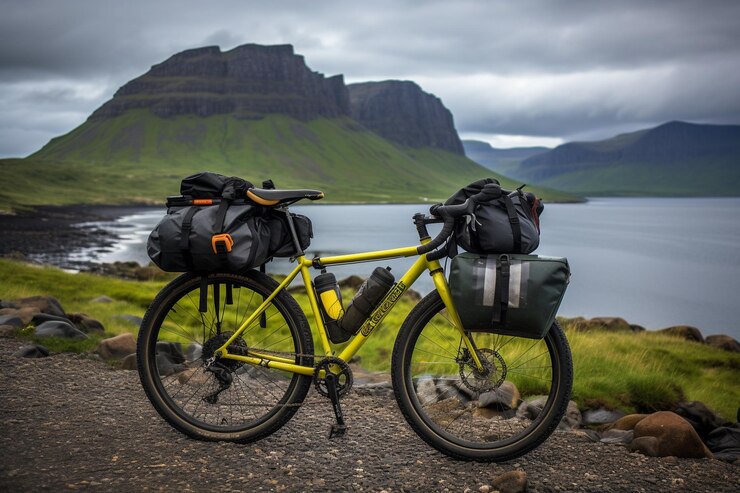
How we tested
We tested this bag on a mountain bike equipped with a dropper post, as well as an off-road dirt touring bike that we also use as a commuter. It worked well across all these applications, handling both rugged trails and city streets with ease. Its ability to use the dropper post—not the entire amount of travel, but certainly more than most full-sized saddlebags can manage—was what truly caught my attention.
Attachment system
This bag had the least side-to-side sway of any we tested, which instantly gave it an edge. The quick-release attachment system is not only secure, but also one of the easiest to remove from the bike—even easier than pulling the dry bag from the Restrap Saddle Bag’s harness in some cases. What makes it even better is how easy it is to detach the entire setup almost effortlessly. That’s why this bag is such a great choice for commuters, who often need to take their bags on and off entirely throughout the day.
Capacity
During commuting around Denver, I used this bag for over 100 miles on my bike, keeping it on for several weeks without needing to take it off. It was perfect for carrying essentials like a jacket, tools, and lunch while running errands around town. What I appreciated most was the extra space—enough for small items from the grocery store on the way home, making it feel like a compact but large, reliable hauler. The conically shaped roll-top dry bag expands well to meet varying needs.
The bag attaches via a quick-release system with an attachment mechanism made up of plastic hooks that hinge onto the saddle rails from the inside. The quick-release bracket slides forward and back to fit different-length rails. A fitting U-shaped piece of polymer sits against the seat post at the base and attaches to the bracket. A Velcro loop on a rubberized strap wraps around the post, holds the bag in place, and effectively sandwiches the post between the strap and the molded support, giving it unmatched stability.
Straps
This bag uses two sets of straps that run from the top to the bottom, and they connect to a rigid plastic sheet that protects the underside of the bag while adding rigidity. One smart feature is the ability to shrink the volume of the bag—just tighten the straps before packing, and it becomes laterally smaller, giving you better tire clearance, especially if you’re using a dropper post. There’s also a main strap with a g-hook that attaches over the roll-top section to secure everything tightly. For added convenience, a shock cord lets you do lashing on top—great for quickly stashing a jacket mid-ride.
Compatibility
While this bag performs well in most situations, it simply doesn’t work with all saddles. For example, I personally couldn’t get it to fit on my Brooks Professional saddle, which was disappointing. According to Ortlieb, Brooks saddles with springs are incompatible, and like I discovered in early testing, you may be in trouble if your saddle rails fold outward.
That said, it wasn’t a total loss. I later tried the bag with a Specialized Power saddle and even a basic seat from a Fairdale Weekender, and it works perfectly with both. It’s also good news that this bag is compatible with the more popular Brooks B17 and Cambium models—I even confirmed that on my roommate’s Brooks Cambium saddle, which fit securely without issue.
Material
As expected from Ortlieb, this bag is completely waterproof, which is perfect for long rides in unpredictable weather. A built-in air valve helps compress your gear as you pack, making things more efficient overall. Still, we noticed that if the valve were closer to the base, it might be easier to stuff gear into the bottom-most, smallest part of the cone, which can be a bit difficult due to trapped air that doesn’t escape easily. This minor challenge aside, the build and design show just how dialed-in Ortlieb’s materials are.
Best saddle bag for road bike: Axiom Seymour Oceanweave Wedge
Material: Made from Oceanweave, a water-resistant fabric crafted with recycled fishing nets, making it eco-friendly and practical.
Weight: Super lightweight at just 2.5 oz, perfect for riders who want minimal bulk.
Capacity: Comes in multiple sizes with a capacity of 0.5 L, 0.8 L, and 1.3 L (if used with a water bottle).
Waterproof: Features a waterproof coating and water-resistant stitching, offering solid protection from splashes and light rain.
Attachment system: Uses a hook-and-loop saddle mounting system that attaches easily and stays secure on road rides.
What we liked: It’s simple, includes an interior zipper pocket, and the fact it’s made of recycled fishing nets makes it a sustainable choice.
What we didn’t like: It’s too small for anything other than a road bike and not durable enough for off-road adventures.
The Axiom Seymour Oceanweave Wedge is our favorite pick when it comes to a small-capacity saddle bag that’s small, light, and surprisingly durable. Made from recycled fishing nets once polluting the ocean, this Axiom Wedge is perfect for road bikes, which typically use a smaller tube and need less space for tools like a flat-fixing kit. We tested the 0.5 L version, and while compact, it’s big enough to fit most spare tubes—as long as you don’t try to carry anything extra.
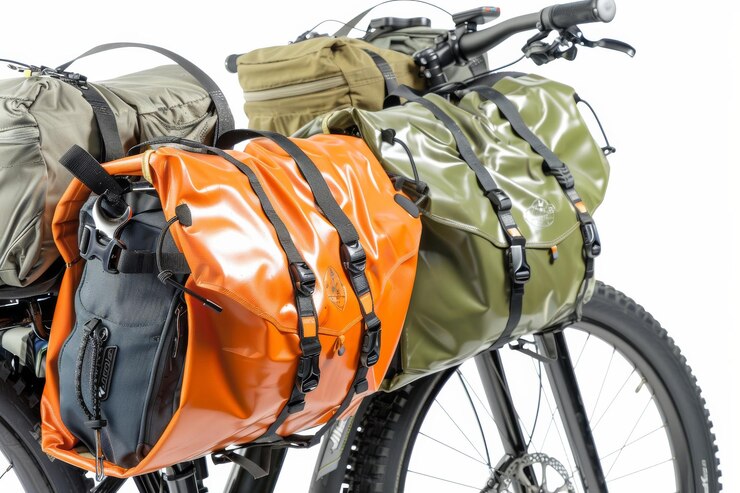
How we tested
We tested this bag extensively on our bike while we commuted through Denver, Colorado, and also while mountain biking across the rugged terrain of Utah. It came with us on some of our favorite local bike paths and commuter trails, where we even clipped a taillight to it for riding at night. From smooth pavement to dusty red dirt trails, the bag performed so well that we often forgot it was even there. And for a small saddle bag, that kind of forgetting is exactly what you hope for—it means it did its job without getting in the way.
Capacity
This bag comes in a 0.5 L size, and the main compartment has a huge ½-liter of space—big enough to fit an extra 29-inch tube, a small multi-tool, and even a tire lever. For such a compact product, it’s a simple bike bag that punches above its weight when it comes to smart, minimal storage on the road or trail.
Material and sustainability
While many small bike seat bags feel pretty similar, this one truly stands out because it’s made from recycled fishing nets, offering an eco-friendly option that supports sustainability. The Oceanweave material not only helps reduce ocean waste but also looks great, giving the bag a clean and modern feel without compromising performance.
Attachment system
The Wedge bag uses Velcro straps to attach securely to both the seat post and saddle rails, making installation quick and easy. A U-shaped zipper opens up the main compartment, giving you full access to the space. Inside the lid, there’s a small zipper pocket that’s large enough to hold 2–3 keys and even a glueless patch kit, keeping the essentials neat and ready whenever you need them.
Long-term durability
We’ve used Axiom bags for years, and they’ve rarely failed us, especially considering the bag’s simplicity. We also didn’t think it would break, but after going through several desert states on a bike rack outside the car and then 80 miles of the White Rim Trail while hanging from the saddle, its tiny U-shaped zipper finally gave out. Thankfully, we heard a distinct thud as our multi-tool hit the slick rock, so we didn’t lose anything we were storing inside.
It’s worth noting that this happened only after very heavy use. Many similarly sized seat bags with small zippers might not survive that kind of abuse, especially if they’re designed more for road bikes. From what we’ve seen, desert dust is tough on any gear, whether it’s a seat bag or a backpacking tent—and that’s something to keep in mind if you ride in rough environments.
Best mountain bike saddle bag: Topeak Aero Wedge Pack DX
Material: Built from rugged 1000-denier Cordura, offering solid abrasion resistance for rough trails.
Weight: Lightweight design at 4.4 oz and 5.28 oz depending on the size, keeping things efficient on your ride.
Capacity: Comes in 0.45 L and 0.54 L versions—just enough for tools and essentials without extra bulk.
Waterproof: No, but features water resistant zippers that provide basic protection in light rain or splashes.
Attachment system: Uses the QuickClick® (F25) mount with a seatpost strap, allowing quick and secure fitting.
What we liked: The saddle rail clamp attachment adds a stable hold, plus there’s a separate side pocket to stash keys and your wallet. It’s also inexpensive, and we loved how easy installation and removal were.
What we didn’t like: The attachment could be more secure on very bumpy or technical trails.
The Topeak Aero Wedge Pack DX is our favorite seat post bag for mountain bikes because of its unique saddle rail attachment system, which secures the bag to your bike’s seat without attaching to the seat post. This smart feature makes it much easier to use with a dropper post, unlike most bags we’ve tried. We tested it on long rides through Moab, Utah, and the Colorado Front Range’s rugged singletrack trails, and it performed better than expected every time.
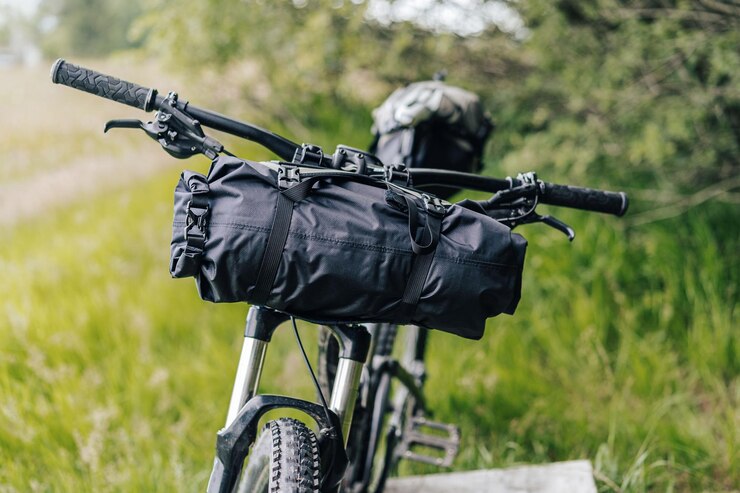
Quick-release bracket
The stand-out feature of this seat bag is definitely the quick-release bracket, which makes removing or securing the bag super convenient. One part of the bracket attaches directly to your saddle rails using a 4-millimeter Allen wrench for install. The other part slides into the bolt-on piece, creating an attachment system that’s both easy to use and reliable once fully installed. Compared to many saddlebags we’ve tested, this bracket just feels more refined.
For added security, there’s a velcro loop to attach the bag to your seat post, although it’s not required—just good insurance in case the bag detaches from the main bracket. What makes this design even more practical is that you can store your tools under the bike seat while keeping full use of your dropper post. Most traditional systems that rely on a webbing strap don’t hold as securely, especially over rough terrain.
Pockets
This bag includes a thoughtful u-shaped zipper opening that opens directly into the main compartment, making access quick and easy. Inside the lid, there’s a small mesh pocket—perfect for tucking away essentials. On the side, you’ll find an accessible zipper pocket that’s large enough to store small flat items separately, and it’s big enough to fit a credit card, ID card, or even a single energy bar without any hassle.
Ease of use
The attachment system on this bag is well-designed, but for some riders, something more simple—like the Axiom Seymour Oceanweave with its velcro strap—might feel more foolproof and perfectly adequate. The quick release bracket on the Aero Wedge Pack is definitely secure, but it’s possible to think the bag is clipped into place when it actually isn’t, which makes it more open to user error. That’s why it might not be the best choice for everyone, especially beginners.
One downside is if you’re using it on multiple bikes, you’ll need multiple brackets, or you’ll have to move the setup back and forth. You can always buy an extra QuickClick bracket from Topeak, and it does work well—as long as you remember to firmly push the bag until it clicked. But paired with a dropper post, this becomes a great seat bag when set up properly.
Best saddle bag for gravel bike: Ortlieb Seat Pack
Material: Made from PU-coated, IP64 rated dustproof and splashproof nylon fabric, tough enough for rough gravel rides.
Weight: Comes in at 16 oz, light enough to balance durability with minimal added load.
Capacity: Available in 11L and 16.5L sizes, giving plenty of room for multi-day bikepacking gear.
Waterproof: Fully waterproof, which makes it reliable even in heavy rain or muddy gravel conditions.
Attachment system: Uses a hook-and-loop fastener for a stable and tool-free setup.
What we liked: It’s lightweight, includes a reflective strip for safety, has a time-tested design, and the external bungee is handy for stashing extra layers.
What we didn’t like: It sways a bit when fully stuffed, and it can be hard to pack items tightly into the bottom corner.
The Ortlieb Seat Pack is the lightest full-sized seat bag we’ve tested, and it stands out as an excellent choice for sub-24-hour overnight bikepacking trips—also known as S24O. It’s especially ideal for a lightweight gravel bike, where minimizing bulk makes a noticeable difference. We packed it for rides on Colorado Front Range dirt and gravel roads, where it performed perfectly even when loaded with a quilt, sleeping pad, and sleep clothes.
This bag is not only fully waterproof, but also smaller than many of the other options we tested, and its simple design just works with every bike we’ve tried. One problem with larger bags is that they can rub against the rear tire when they bounce, especially on a smaller bike or if your seat is adjusted lower. We had none of those issues here—this bag stayed clear, stable, and totally out of the way.
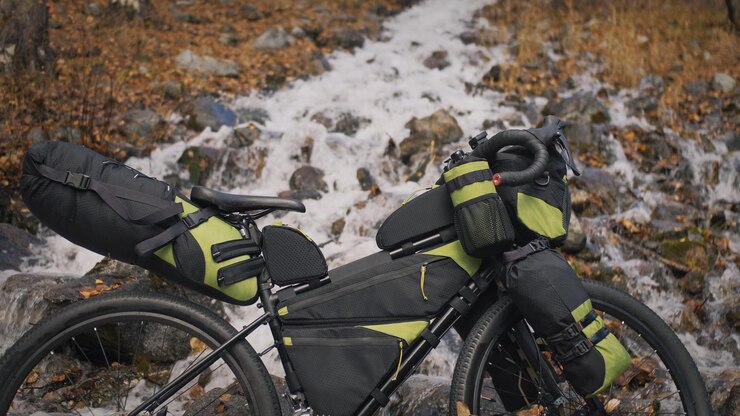
Construction
This is basically an 11-liter waterproof compression stuff sack with a few strong straps to hold your stuff in place. It’s made with a waterproof coated ballistic nylon ripstop material that feels much lighter and less rubbery than the heavy fabric used in Ortlieb’s original bike touring bags. That makes it a solid upgrade for riders who want durability without excess bulk.
Unlike many bikepacking seat bags that fall into the 18–24 ounce range, this seat bag weighs just 12 ounces (345 grams)—nearly half the weight of most full-sized saddle bags we tested.
Attachment system
The attachment system on this bag combines snap buckles with integrated ladder-locking cam buckles for a secure fit. A stiff, rubbery strap with velcro wraps around the seat post to attach the bag at its base, holding it firmly in place even on bumpy rides. The roll-top closure extends into a large cone, which not only improves storage but also makes packing smoother and quicker out on the trail.
Compression
This bag uses compression straps to hold the roll-top closure down and compress your gear once it’s packed, keeping everything snug and stable. You can also add another strap to the bottom of the bag, wrap it around the roll-top end, and connect it to your seat to keep it from moving around even more when going over rough terrain.
Ease of use
Although this saddlebag is easy to install and uninstall, it’s definitely easier to pack your gear when the bag is off the bike. For many bikepacking trips, you may not want to pull every bag off every night, but with this one, you’ll need to pack and unpack it off the bike for best results. The bottommost corner of the cone is very small, and the waterproof material is completely airtight, so letting gravity help while loading it becomes necessary.
When I was testing it the first time, I had a jammed finger, and the extra force and finger dexterity required to cram my quilt into that tiny corner made things more difficult. Still, being half the weight of others and fully waterproof, I don’t mind the extra work it takes to get everything in securely.
Ortlieb Seat Pack vs. Ortlieb QR Seat Pack vs. Restrap Seat Pack
If you want a light saddlebag for short rides, the Ortlieb Seat bag is a solid pick. But its durability might not hold up for longer, tougher trips. Although it lacks a bottom guard, the regular, lighter Ortlieb Seat Pack is made of the same material as the heavier Ortlieb Seat Pack QR (22 oz). This means the thin bag material could get damaged if it rubs on your tire during rough rides.
On the other hand, the Ortlieb Seat Pack QR comes with a plastic sheet on the bottom to protect it, making it more suitable for big adventures. If you’re planning to carry more gear, like using the larger, 16-liter size version, we’d definitely steer you toward the QR model. And for even more durability, especially off-road, the Restrap seat pack made with 1000-denier Cordura is tough and built to last. For light loads, the smaller, 11-liter bag probably won’t touch rear tires, so the basic Ortlieb might still do just fine.
Related: What Are Bike Stems?
Best affordable bike saddle bag: BV Bicycle Strap-On Bike Saddle Bag
Material: Nylon
Weight: 3.8 oz
Capacity: 0.4 L, 0.7 L, 1 L
Waterproof: No
Attachment system: Strap on, mounting, designs
What we liked: Expandable, low profile, key clip, easy to install, very inexpensive
What we didn’t like: Inner pockets, could be better
The BV Bicycle Strap-On Bike Saddle Bag stands out mainly for its price—it’s incredibly affordable without sacrificing performance. It performs just as well as many other saddle bags that cost nearly twice as much, which makes it a great option for budget-minded riders. I’ve used this on long rides, including riding the White Rim Trail, and found it met the basic criteria for what a functional bag should be.
It’s great at holding your essential tools like a bike puncture repair kit, with some space still left over. Even on bumpy trails, it stays put without falling off, which is impressive for a smaller-volume bag. There isn’t much that can go wrong, and this one checks all the boxes. It performs similarly to others in its size class but costs way less, which is why I often recommend it to beginner and casual bikepackers.
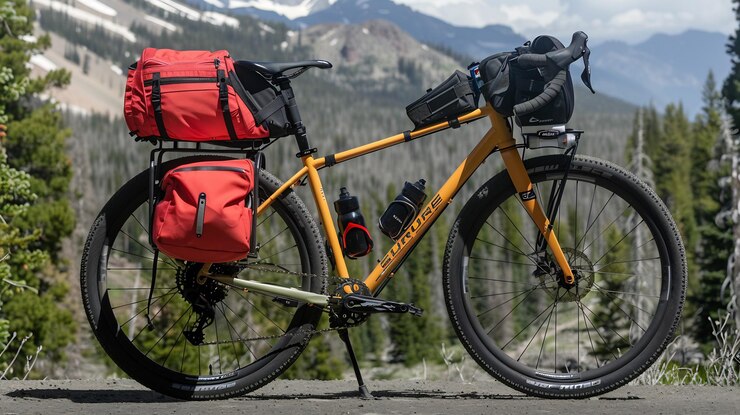
Design
One feature I found surprisingly useful while testing saddlebags for long rides was a webbing strap combined with a clip and a ladder lock adjuster that helped attach the bag firmly to the bike. It locks securely to the saddle rails, and I liked how the design included loops to thread the strap through, which prevented it from moving or shifting mid-ride.
Attachment
When testing inexpensive saddle bags, I noticed that many rely only on velcro for their attachment system, but this bag adds a plastic buckle, which makes it more reliable in the short term and long term. While buckles won’t wear out as quickly as velcro, it still includes a velcro strap to secure the bag to the seatpost, which is common in nearly all models and adds that extra bit of stability.
Expandable capacity
An under-seat bicycle bag with an expandable design is a game-changer for long rides. This one unzips near the bottom to increase its capacity by about 30%, which made a huge difference on our White Rim Trail adventure—a 100-mile unsupported ride where every inch of space mattered. We had our bags tightly packed with food, water, and essentials for the entire day, and that extra room helped us fit three energy bars in addition to a tube, tire lever, multitool, tubeless repair kit, and even a windbreaker.
The u-shaped zipper opens the bag into the main compartment, and inside there’s a main pocket with a smaller mesh pocket and a key clip. Though it’s not flashy or high-tech, this affordable setup carries all your gear and stands up to rough use just as well as expensive counterparts.
Other bike saddle bags we tested
Topeak Backloader X
Material: Nylon, Polyethylene, Engineering grade polymer, Anti-slip PU leather
Weight: 19.4 oz
Capacity: 10 L, 15 L
Waterproof: Waterproof carry bag
Attachment system: Holster, hook and loop fastener, buckle fastener
If you’re looking for a large, affordable bike bag, the Topeak Backloader X is a great choice we’ve tested, especially for commuters on a tighter budget. While it follows a design similar to the Deuter Cabezon and Restrap Seat Bags—using a separate harness and dry bag that fits inside—it doesn’t work quite as well in terms of stability or finish. However, it’s a practical pick for those who want a high-capacity setup that costs less than premium bags like the Cabezon.
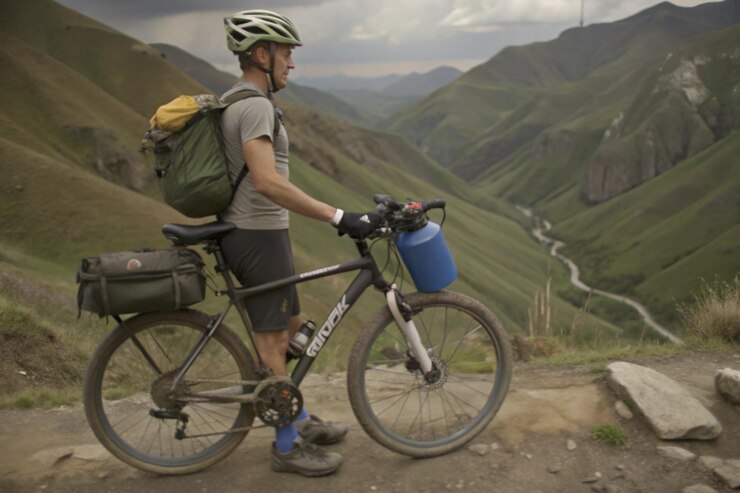
The Backloader X is a solid option if you’re looking for a large-capacity, affordable saddlebag for bikepacking or everyday use. We tested it with the Backloader Wishbone, which stabilizes the bag and adds extra places to mount water bottles. While you don’t need to run them in tandem, they work better together—cutting down on sway with that extra stabilization. Just note that using both isn’t as budget-friendly as the bag may seem initially.
We packed it with camping gear, went off road, and even used it for grocery shopping and trips to the gym during the week. The removable dry bag slides out easily from the harness, and the 15-liter capacity handled a change of clothes, lunch, and a jacket with room to spare. The outer harness is made from heavy-duty Polyethylene and lined with rubberized fabric on the top and front where it meets the saddle rails and seatpost, helping it last longer through rough use.
Inside, the dry bag includes a roll-top closure, air valve, and a tapered bottom to slide into the conically shaped harness snugly. A large velcro strap helps attach the inner bag to the seatpost, while straps and camming buckles connect the outer bag to the seat post rails. The harness even velcros securely to the Wishbone, adding extra hold and confidence on rugged rides.
Topeak Backloader X vs Topeak Backloader
The Backloader X and Backloader are clearly different, and the main difference between the two bags is how they attach to the bike. The Backloader follows a one-piece bag design that gets strapped directly onto the frame, similar to the Ortlieb Seat Pack or Revelate Spinelock. While it includes an inner dry bag, you’ll still need to unstrap everything to repack. On the other hand, the Backloader X features a harness and dry bag design that lets the harness stay on the bike—you simply remove the waterproof stuff sack to unpack and go.
When I tested both, I found the Backloader X sways less than the standard Backloader, especially over rocky terrain. It’s also easier to pack and unpack once you’ve mounted the harness. Oddly, neither bag shows up under the saddle bag category on the Topeak website—the only way I could find them was by searching “Backloader X.” Definitely a bit weird, but worth the effort.
Using The Topeak Wishbone with Saddlebag
The Wishbone can be difficult to install, even for someone like me who’s been a bike mechanic for over a decade. If it feels hard to install for a pro, your average at-home tinkerer might really struggle. It has several bolts, and getting them into the right place to properly fit the Backloader and its harness bag can be tricky. During one test, the hardware came loose after just an hour of riding, and I had to remove the bag and tighten everything again.
To fix the issue, I added blue Loctite, a semi-permanent thread locking compound, to prevent the bolts from coming loose. While it does offer extra water-carrying capacity, I’d say the Wishbone isn’t a necessary component for everyone using a saddle bag—especially if your rides don’t demand that extra function.
Set Up for Topeak Backloader X
Setting up the Backloader X can be a bit tricky at first. Attaching the harness involves having to thread the straps through a loop and then secure them with a camming buckle. Honestly, clips would have made it much easier. During the initial setup, I had to redo it a couple of times before getting a snug fit. It’s a bit of a challenge, especially if you’re not used to saddlebag setups, but once dialed in, the stability is worth the effort.
This large capacity bag was actually the only bag we tested that felt oversized for our medium test bike, a Surly Ogre. We had to retighten the camming buckles after they loosened and the bag got pulled too close to the seat, risking rubbing against the rear tire during testing. That said, it’s a great option for larger frames, especially if you’ve got more than six inches of seat post sticking outside the frame.
Revelate Terrapin
Material: 200-denier, TPU-laminated, ripstop, nylon, waterproof
Weight: 17 oz
Capacity: 8L
Waterproof: Waterproof
Attachment system: Indie-Rail, system
What we liked: Durable, easy to install, remove, easy to pack, stable, classic, bikepacking, seat bag
What we didn’t like: Replaced, models, newer
When I first started serious bikepacking expeditions, my go-to was the legendary Revelate Viscacha—a trusty seat bag I’ve had since 2015, which has survived over 3,000 miles of rough riding. This early model set the standard during our extensive testing phase, thanks largely to its clever design: a durable conically-shaped stuff sack with a secure roll-top closure, reinforced by rigid plastic on the bottom and sides. Its unique setup features two straps that conveniently attach and compress the bag snugly toward the seat post, plus an exclusive interior compression strap to keep your gear stable below its maximum height.
Today, the upgraded Terrapin with the innovative Spinelock mounting system is my top recommendation as an adequate replacement. Having personally put this newer model through rigorous rides, it combines the proven reliability of the original Viscacha with enhanced convenience, making it an excellent choice for any planned adventure.
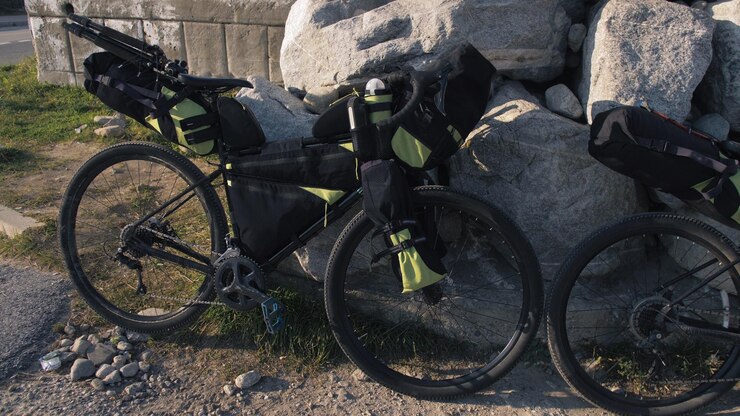
Topeak Backloader X
Material: For severe bikepacking journeys, the 210-denier ripstop nylon construction ensures a sturdy and dependable product.
Weight: Reasonably light at 1 lb. 8 oz., perfect for extended trips without adding extra burden.
Capacity: Offers ample storage with 16L, making it easy to carry essential gear.
Waterproof: Completely waterproof, safeguarding your possessions in damp environments.
Attachment system: Equipped with the convenient Indie-Rail attachment system, known for being easy to install, easy to remove, and exceptionally stable during rides.
What we liked: Its classic design and straightforward functionality make it very easy to pack, which I’ve appreciated personally on several multi-day outings.
What we didn’t like: Gradually being replaced by newer models, potentially making it harder to find spare parts or replacements in the future.
When I first got serious about bikepacking, I relied on the legendary Revelate Viscacha for countless expeditions. It was a rugged bag, tested repeatedly on tough trails. However, when the Spinelock emerged as a replacement, I quickly saw why it’s an excellent choice.
The Spinelock incorporates a cleverly designed rigid rubberized material at the seatpost and saddle rail interface, providing a stable mount that’s easy to secure. The main body of the bag is crafted from X-Pac, a lightweight yet extremely durable fabric. While the material itself is waterproof, the seams aren’t fully sealed, making it reliably water-resistant rather than entirely waterproof. Personally, I’ve never faced issues with my sleeping bag getting wet inside the Spinelock—even without a dedicated waterproof stuff sack.
One of my favorite features is its mounting system: it uses two straps equipped with convenient ladder-locking buckles and cams, ensuring the bag stays securely attached to the seat. These straps connect to another more rigid strap above the saddle rails, adjustable forward or back depending on your saddle’s position on the clamp. Plus, there’s an additional stiff 2-inch velcro strap at the seatpost for extra stability, perfect for the varied terrain you might encounter on your next planned adventure.
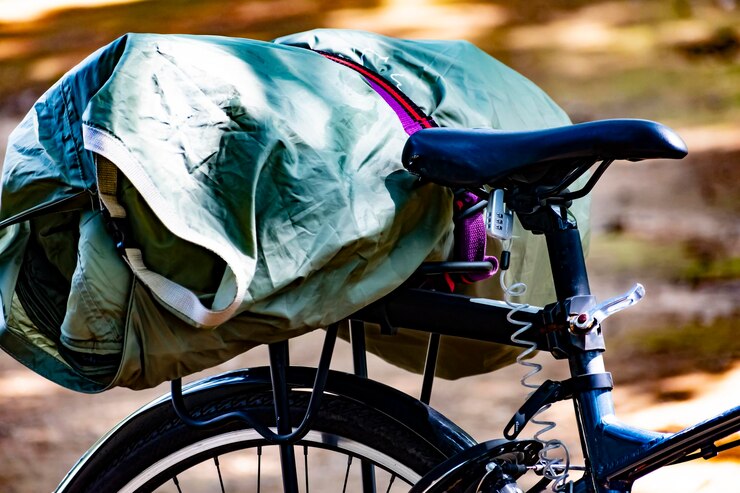
How to use a seat bag
What do you keep in a saddle bag?
When packing my saddle bag, I prioritize essential repair items and reliable tools to handle unexpected issues on the trail. At minimum, I keep a spare tube, a compact yet versatile multitool, and a sturdy tire lever for quick tire changes. Additionally, a compact tubeless repair kit and some durable zip ties come in handy for trailside fixes. I also carry materials to boot a tire in emergencies, and I always bring along a lightweight pump unless it’s conveniently mounted directly to my bike frame.
What’s the ideal saddle bag size?
The ideal saddle bag size truly depends on the type of rider you are and what you plan to carry on your bike. For short, recreational day rides, a compact bag in the 1-3 liter range is usually sufficient. However, if you enjoy longer rides or an all-day gravel epic, choosing a larger saddle bag between 3-8 liters is more practical.
When it comes to extended bikepacking trips, you’ll want a bag with over 10 liters of space. Personally, I’ve found it useful to supplement a bigger bag by adding a handlebar bag or a frame bag to my overall bike bag setup, making it easier to organize gear and balance weight on longer adventures.
How do I set up a saddle bag?
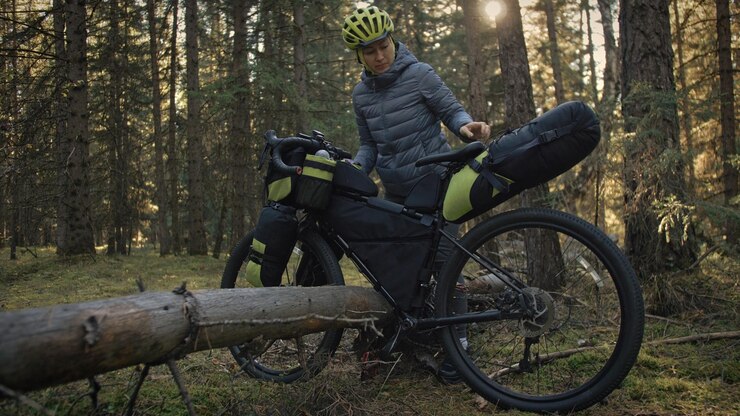
Step 1: First, loop the straps on the bag’s sides through your saddle rails, then clip them securely so that the bag is hanging comfortably from the rails.
Step 2: Next, attach the bag firmly to your bike’s seatpost, making sure it’s stable and centered.
Step 3: Finally, tighten the straps around the saddle rails as needed, ensuring the bag won’t shift during your ride.
What to look for in bike saddle bags
Material
Selecting a high-quality saddle bag composed of sturdy materials is essential for effective bikepacking. The parts of the bag rubbing against the seat post and underside of your saddle should ideally have reinforced materials. This is especially true for larger saddle bags, which tend to sway more during rides. Personally, I’ve found that winning bags often use robust fabrics like X-Pac or Cordura, or have built-in features to protect lighter, less durable materials from wearing out quickly.
Weight
Controlling weight is essential while packing for a bikepacking trip. A heavy saddle bag can cause your bike to swing noticeably from side to side, especially when you stand up to pedal uphill. Although a lightweight bag is generally a good idea, most experienced cyclists know the stuff they carry often ends up heavier than the bag itself. From experience, a super light bag may seem appealing at first, but it often turns out to be less durable in the long run.
Aerodynamic design
The aerodynamic design of a saddle bag definitely matters, though not necessarily for strictly aerodynamic reasons like impacting speed. In reality, boxier bags often sway more, causing the backs of your legs to hit them during every pedal stroke if they’re not spaced adequately away from your saddle. To avoid this frustration, I typically recommend tube-shaped or cone-shaped bags.
Water-resistant or waterproof?
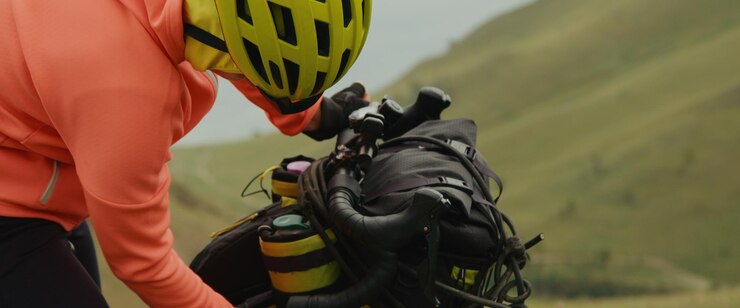
A saddle bag that is waterproof or at least water-resistant is a great attribute to put first. Saddle bags get particularly dirty because they’re positioned just above your rear tire, where they’re constantly sprayed by mud, water, road grime, or even tire sealant. Therefore, having a bag with solid protection against moisture and dirt isn’t just beneficial—it’s genuinely important for keeping your gear safe and dry during extended trips.
Capacity and usable storage space
Choosing the right capacity for your saddle bag is crucial, depending on what you typically carry. For example, a mountain bike rider will need more space, as their spare tube is often twice as large as a spare road tube.
Types of attachment systems
The straps on saddle bags are usually made of webbing and go through the rails under your seat. The straps are usually held in place by Velcro, cams, buckles, or a combination of these.
Velcro Strap
Velcro is the most widely used saddle bag attachment method, particularly for lighter loads. Velcro makes it extremely easy to attach and remove the bag from your seat post or bike. While it’s convenient for quick setups, keep in mind that Velcro tends to wear out over time, especially after frequent use or long trips.
Cams
Another reliable method involves using cams, which typically secure the bag with straps that loop through your saddle rails. From my experience, cams offer a very firm attachment, though they can sometimes be slightly harder to adjust, especially if you’re frequently swapping bags between bikes or adjusting your setup mid-ride.
Buckles
Personally, I’ve found that buckles often provide the best combination of ease and security. They allow you to quickly and easily attach the bag to your saddle rails, and you can also effortlessly tighten them to ensure a secure fit on your rides.
Reflective material
Having reflective material on your saddle bag is a nice touch, especially if you frequently find yourself riding around cars at dusk or in low-light conditions. However, this alone shouldn’t be fully relied on for visibility. In my experience, if you’re regularly riding at night, pairing your bag with a bright blinking light is always best to stay safe.
Number and size of pockets
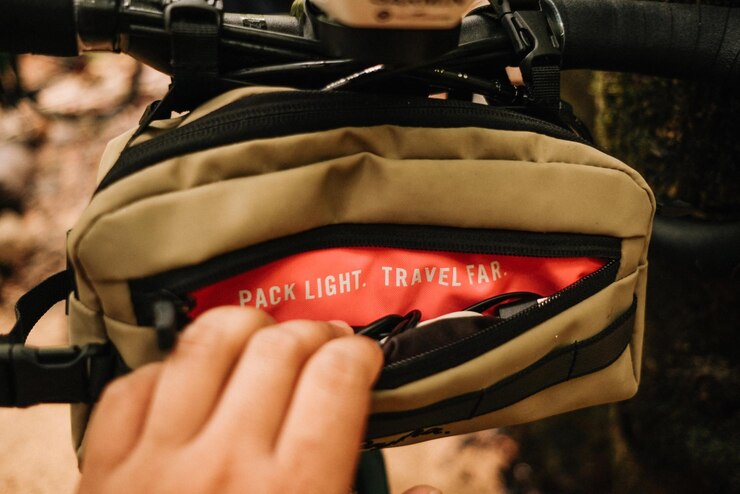
Look for saddle bags equipped with external pockets, as these provide easy access to items you frequently use without opening the main compartment. Bags featuring multiple pockets inside also help keep your gear neatly organized.
Rigidity
A big saddle bag must be rigid enough to prevent sagging, especially if it extends beyond the main attachment system. This extended portion should ideally include something stiff to prevent it from bending down, potentially causing unwanted contact with your rear wheel when you encounter bumps. After testing various bags on rough trails, I’ve learned firsthand how essential rigidity is for comfortable and reliable bikepacking.
How to choose a saddle bag
Bikepacking
When planning a bikepacking trip, picking one of the biggest saddle bags is essential. A good seat bag for bikepacking should provide enough room for your essential gear, like a sleeping bag, a cozy quilt, an inflatable sleeping pad, a lightweight puffy jacket, and your sleep clothes. From personal experience, look for bags with compression straps on both the interior and exterior—they make fitting everything much easier.
Gravel Bike
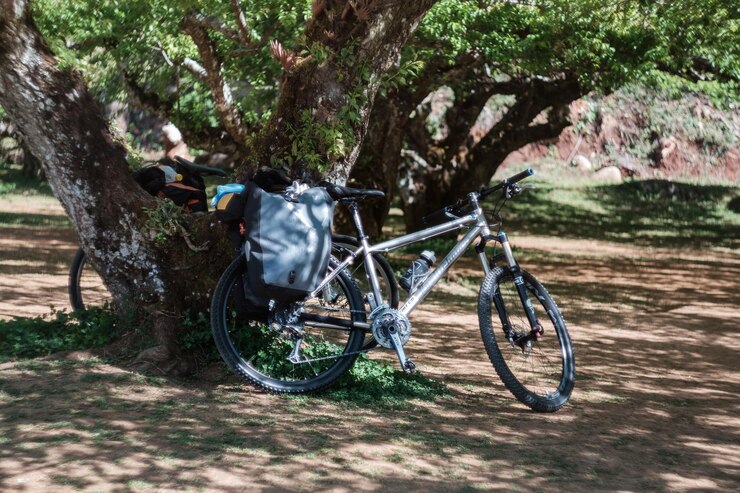
For gravel riding, gravel riders typically go farther off the grid compared to road cyclists. Although gravel bike seat bags are often similar in size to road cycling seat packs, you’ll likely prefer a slightly larger saddle bag. In my experience, having a bit of extra space helps accommodate additional tools or layers comfortably, which can be crucial when exploring remote trails.
Road Cycling
For road bike riding, you generally want one of the smallest bags available. A typical road cyclist needs to carry only basic gear such as a spare road tube, a compact tire lever, a versatile multitool, and a quick CO2 inflator for emergency repairs during a typical road ride. There’s no real advantage to having a huge saddle bag on your road bike, so choosing compactness and minimalism is best.
Overnight
If you’re planning overnight trips, you don’t necessarily need the biggest bag available. While overnight bike saddle bags are similar to bikepacking seat bags, they’re often slightly smaller because you won’t need to carry as much extra gear. In my experience, a well-sized bikepacking saddle bag can double for short bike camping outings and shorter trips—just ensure the seat bag has room for your basic sleeping essentials and layers.
Commuter
Commuter saddle bags are practical and roomy, similar to gravel bike bags, and they usually come with a bit of extra room for daily essentials. I frequently stuff the bag with tools, a jacket, and occasionally even lunch.
Leather
For those who love classic looks, leather saddle bags are a good pick. Not only are they highly durable, but they also appeal to cyclists who use a leather saddle, as the bag naturally matches the look of their bike. Keep in mind that most leather saddles mount to saddle loops, which are often found only on vintage models or custom setups.
E-Bike
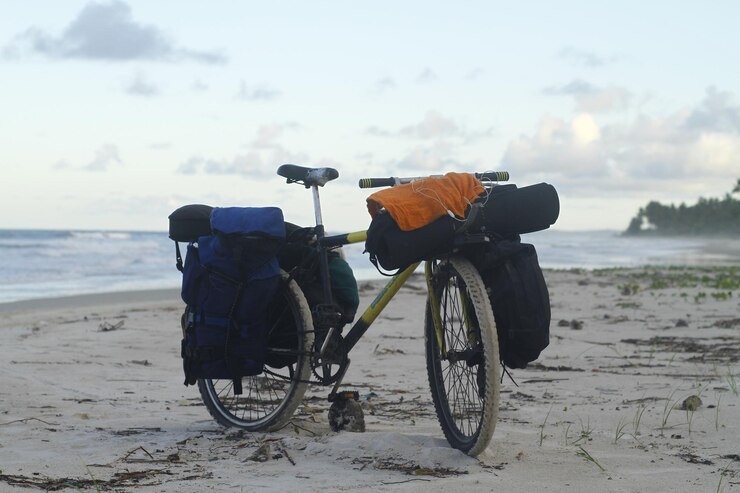
Similar to other saddle bag types, e-bike saddle bags function similarly. Since e-bikes come in different shapes and sizes, just like analog bikes, your bag choice should be based on how you plan to use the bike. Whether you need storage for tools, gear, or day-trip items, there’s a saddle bag to fit your specific riding needs. Matching the category of use to your e-bike helps you stay organized and efficient.
FAQs
What is a saddle bag?
Bike saddle bags—also known as bike seat bags—are a type of bike bag that’s attached beneath your bike seat. These bags secure to saddle rails, which are typically made of metal or carbon, and help clamp the saddle to the seat post. For larger-volume setups, it’s especially important to also attach the bag to the seat post itself to help stabilize the load during rides.
Are a saddle bag and seat bag the same thing?
Indeed, a saddle bag and a seat bag are the same kind of bag; bikers use the terms interchangeably. Both refer to the storage bag that fits neatly under your bicycle’s seat, often used to carry tools, spares, or small gear for bikepacking or everyday rides.
When on your bike bag-buying journey should you get a saddle bag? Is it the first bag?
Saddle bags, also called bike seat packs, are often one of the first bags that many cyclists purchase when they begin carrying gear on their bikes. I remember starting with a small seat bag myself—it was an inexpensive and simple way to stash a spare inner tube, multitool, and tire levers. These small under-seat bicycle bags are compact and don’t negatively affect how the bike handles, which makes them a great beginner-friendly option. If you’re not into bike mounted bags, you might prefer setups from our Best MTB hip packs and MTB backpacks guides instead.
Once you’re farther into your bike bag-buying journey, especially if you’re planning extended rides, switching to bikepacking bags becomes more important. A saddle bag for bikepacking turns into an essential part of your gear setup, helping you pack smarter and ride longer.
What are the advantages of a saddle bag over handlebar and frame bags? Why can't we just use a jersey pocket?
While you can use a jersey pocket to carry your bike tools, it’s not always the most comfortable choice. On longer rides, I’ve found that stashing a multitool, pump, and tire levers in my jersey pockets often leads to digging pain in my back or hip. A MTB hip pack or backpack helps a bit, but keeping heavier items off your body and mounted to the bike is just smarter and far more enjoyable over time.
From years of riding bikes, I’ve come to avoid wearing a cycling jersey unless I’m in a full cycling kit. Being able to ride in normal clothes is more liberating, and a good bike seat bag supports that freedom by offering storage without needing to dress like you’re racing.
Now when it comes to alternatives like bike handlebar bags or frame bags, sure—they carry gear too, but they come with downsides. For starters, making a reliable handlebar bag or frame setup is more complex and often expensive, while a simple saddle bag gets the job done for less. A quick stop at your local bike shop usually shows this: more seat bag options, more variety, and gear that usually costs less than the one or two high-end bar bags they have in stock.
Frame bags, in particular, are even pricier and can cause fit issues. They often block your water bottles from sitting in the center triangle. While some smaller frame bags allow you to mount water bottle cages, if you have a smaller-sized bike, that space is really limited.
What are the disadvantages of saddle bags compared to handlebar bags and frame bags?
There are a few drawbacks to using a saddle bag instead of a handlebar bag or frame bag, especially when it comes to mounting a rear light or using a dropper post. A large saddle bag might prevent you from fully using your dropper on a mountain bike or gravel bike.
Still, many dropper post-compatible seat bags exist, and if you’re riding technical terrain, make sure your bag attaches only to the saddle rails to keep things working smoothly. In tight setups, a small frame bag can be a viable alternative for mountain biking, though you’ll need to watch how it interacts with your suspension and access to water bottles.
In my experience, it’s often easier to find a saddle bag that works with your dropper post than finding that rare unicorn of a frame bag that fits everything just right. Light mounting can also be a challenge—while a saddle bag can make it tricky to mount a light to your seat post, many do offer a place to clip one on. Even handlebar bags can lead to light mounting issues, so sometimes the problem is only solved by going with a compact frame bag instead.
Is a big saddle bag the same as a seat pack?
A big saddle bag is generally the same as a seat pack—they both fall under the category of saddle bags and mount directly to your bike’s saddle. However, some riders confuse them with bike panniers, which are actually not the same. Bike panniers are larger bags that mount to a rack rather than under the saddle, and they’re typically used for touring or commuting with more cargo.

